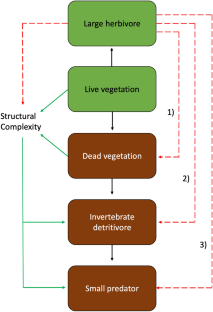UNSWの科学者が、砂漠の食物連鎖に大きな影響を与えることを明らかにした。 A reduction in decaying vegetation can have significant impacts on the desert food chain, UNSW scientists have found.
2023-01-31 ニューサウスウェールズ大学(UNSW)
◆シドニー工科大学の科学者たちは、過放牧が、枯れた植物、シロアリ、シロアリを主食とする動物の間に存在する砂漠の食物網を破壊する可能性があることを明らかにしました。この最新の発見は、オーストラリアの乾燥地帯における生物多様性の保全に重要な意味を持ちます。
◆生物・地球環境科学部の研究者らは、南オーストラリアの乾燥地帯で野外調査を行い、その結果を「Ecosystems」誌に発表しました。
◆主著者である博士課程の学生バティスト・ウィジャス氏とマイク・レトニック教授は、シロアリやミミズなどの腐食動物が死んだり腐ったりした植物を消費することで成り立っている褐色食物網を観察しました。簡単に言うと、カンガルーは植物が成熟し、乾燥し、腐食動物の餌になる前に食べてしまうのです。
◆研究者たちは、非政府組織ブッシュ・ヘリテージ・オーストラリアが管理する保護区、ブールクマッタ・ステーション・リザーブに焦点をあてて研究を行った。ブールクマッタの伝統的所有者は、アドニャマタンハ族とウィルジャカリ族である。
◆ブールクマッタ保護区は、南オーストラリア州のディンゴフェンスの内側にあります。この地域では、羊の放牧が主な土地利用であり、食物連鎖の頂点に立つ捕食動物であるディンゴが「機能的に絶滅」しています。つまり、ディンゴの数が減りすぎて、カンガルーや野生のヤギなど、放し飼いにされている餌生物に与える影響が無視できないほどになってしまったということです。
◆研究チームは、カンガルーを排除した囲いの中の生木や枯れ木、腐食性シロアリの生息数、捕食者を、近くの対照区と比較した。その結果、カンガルーがいない囲いの中では、生木も枯れ木もより多く茂っていることがわかった。その結果、囲いの中ではシロアリや、シロアリを捕食するトカゲやダンナといった小型の脊椎動物がより多く生息していたのである。
◆これらの小型脊椎動物は砂漠環境における生物多様性の重要な構成要素であり、大型有袋類、猛禽類、ヘビ、ゴアナなどの大型動物の餌となることで、砂漠の食物網において重要な役割を担っている。
◆今回の研究は、より肥沃な別の環境で行われた研究結果とは対照的で、草食動物の存在が動物の分解者の個体数を増加させることが明らかになった。
<関連情報>
- https://newsroom.unsw.edu.au/news/science-tech/brown-food-web-dead-vegetation-plays-essential-role-desert-ecosystems
- https://link.springer.com/article/10.1007/s10021-022-00810-4
草食動物の影響は乾燥地の褐色食物網を経由して連鎖する Herbivores’ Impacts Cascade Through the Brown Food Web in a Dryland
Baptiste J. Wijas,Graeme Finlayson & Mike Letnic
Ecosystems Published:12 December 2022
DOI:https://doi.org/10.1007/s10021-022-00810-4

Abstract
Food webs can be conceptualized as being powered by energy derived from living and dead vegetation, respectively. Most food web research has focused on “green food webs” which begin with the consumption of living vegetation by herbivores. However, “brown food webs” which stem from the consumption of senescent vegetation by detritivores are also an important channel of energy transfer. In theory, herbivores have the potential to disrupt brown food webs by consuming plant material before it can senesce and become available for detritivores. Here we investigate the effects that grazing by kangaroos, whose population had irrupted partly due to the absence of an apex predator, has on the brown food web in an arid environment. We compared the cover of living and dead vegetation, the abundances of detritivorous termites and their predators inside one ha herbivore exclosures and nearby control plots. Results show there was more cover of living and dead vegetation inside the exclosures. Similarly, abundances of termites and small vertebrate predators of termites were greater inside the exclosures. Our study provides evidence that consumption of plant material by irruptive herbivores can disrupt the functioning of the brown food web by reducing the flow of energy from plant biomass to termites which in turn translates to reduced abundances of termites and small vertebrates that feed on termites. Our findings have implications for conservation and management because they shed light on a previously unconsidered threat to the functioning of arid ecosystems, disruption of brown food webs by irruptive herbivores.


